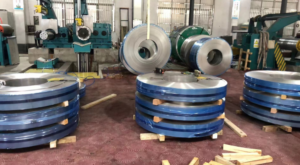ในสาขาวิศวกรรมโลหะวิทยาและวัสดุ เพิก และ แผ่น metal are two terms that are often used interchangeably, but in reality, they possess distinct characteristics and applications. As a seasoned expert in the field of metal materials from ซิโนสแตนเลส, I am well-versed in the ความแตกต่างระหว่างแถบและโลหะแผ่น. This article aims to provide a comprehensive and authoritative comparison between strip and sheet metal, highlighting their key differences.

อะไรคือความแตกต่างระหว่างแถบและโลหะแผ่น?
Firstly, let’s delve into the fundamental definition of strip metal. Strip metal refers to a narrow band or ribbon of metal, typically having a width that is significantly less than its length. It can be produced in various thicknesses, ranging from extremely thin foils to thicker gauges suitable for structural applications. Strip metal is often used in the manufacturing of electrical components, springs, fasteners, and other precision parts where narrow widths and specific thicknesses are required.
On the other hand, sheet metal is a broader category that refers to thin, flat pieces of metal with considerable area. Sheet metal is typically thicker than strip metal, with thicknesses ranging from fractions of a millimeter to several millimeters. It is widely used in various industries, including construction, automotive, and aerospace, for fabricating parts, enclosures, and structural components.
One of the primary differences between strip and sheet metal lies in their dimensional characteristics. Strip metal, as mentioned earlier, is narrower in width compared to its length, making it suitable for applications that require long, thin pieces of metal. In contrast, sheet metal is characterized by its larger surface area, allowing for the production of larger parts and components.
Another significant difference is in their manufacturing processes. Strip metal is often produced through continuous casting or rolling operations, which yield long, continuous rolls of metal. This continuous production process enables high efficiency and scalability, making it suitable for mass production. On the contrary, sheet metal is typically produced in discrete pieces through cutting or shearing operations from larger metal blanks. This process allows for greater flexibility in terms of size and shape, but may not be as efficient for large-scale production.
Moreover, the mechanical properties of strip and sheet metal can vary depending on their composition and manufacturing processes. Strip metal, due to its narrow width and potential for thinner gauges, may exhibit different tensile strength, yield strength, and ductility characteristics compared to sheet metal. These properties can have a significant impact on the performance and usability of the metal in specific applications.
In terms of applications, strip metal finds widespread use in the electronics industry, where its narrow width and precision thickness are crucial for the manufacture of components like resistors, capacitors, and circuit boards. It is also used in the manufacturing of springs and fasteners due to its elastic properties and ability to be shaped and formed.
Sheet metal, on the other hand, is ubiquitous in the construction industry, where it is used for roofing, siding, and structural framing. Its larger surface area and thicker gauges make it suitable for withstanding the rigors of outdoor exposure and structural loads. In the automotive industry, sheet metal is employed in the production of body panels, hoods, and other exterior components that require both strength and aesthetics.
Additionally, the surface finish and coating options for strip and sheet metal can differ. Strip metal, often used in precision applications, may require specific surface treatments or coatings to enhance its electrical conductivity, corrosion resistance, or wear properties. Sheet metal, on the other hand, may be coated or painted for aesthetic purposes or to improve its durability in outdoor environments.
สรุป
In conclusion, strip and sheet metal, while both forms of thin metal, possess distinct characteristics and applications. Strip metal is narrower, thinner, and often used in precision manufacturing, while sheet metal is thicker, larger, and suitable for structural and larger-scale applications.
Thank you for reading our article and we hope it can help you to have a better understanding of the differences between strip and sheet metal. If you are looking for strip and sheet metal suppliers and manufacturers online now, we would advise you to visit ซิโนสแตนเลส.
As a leading supplier of stainless steel products from Shanghai China, Sino Stainless Steel offers customers high-quality stainless steel strips, stainless steel sheets, ขดลวดสแตนเลส, หลอดสแตนเลส, ท่อสแตนเลส, แผ่นสแตนเลสและ แท่งสแตนเลส ในราคาที่แข่งขันได้มาก
 :+86-18621535697
:+86-18621535697  :export81@huaxia-intl.com
:export81@huaxia-intl.com